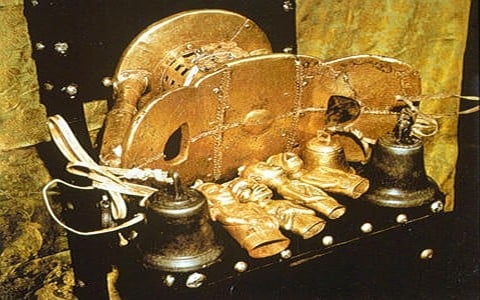Hope you enjoy the latest episode of the History of Africa podcast. This episode, we picked up right where we left off last time. Osei Tutu is a fugitive prince who has just returned to his hometown of Kumasi, with his Denkyira former captors too busy with wars in the South to pursue him north. However, a lull in the violence in the Denkyira's south allowed them to turn their attention back to the North, and finally focus on recapturing the renegade prince in Kumasi.
However, Osei Tutu was not in a capitulary mood. He had spent the last several years building a powerful army, one which used modern organization, tactics, and bureaucratization. This new force, he hoped, would finally be enough to equal the Denkyira's strength.
 |
| The famous Ashanti golden stool |
After luring the Denkyira deeper and deeper into Ashanti territory, the Ashanti army ambushed the Denkiyra at the small village of Feyiase. The shocked Denkyira were routed, and their king was killed in battle. After his victory, Osei Tutu had secured victory for the Ashanti and neutralized the Denkyira threat. With this new, united army at his disposal, he quickly elevated his status from the king of Kumasi to the king of all of the Ashanti, or Asantehene. However, rather than vesting power in himself, the forward looking Osei Tutu decided to technically vest the power into an artifact which would outlive him. The golden stool, a throne which supposedly descended onto Osei Tutu's lap from heaven, would be the true symbol of power in the Ashanti empire. Now that power had been invested into a physical object, Osei Tutu's empire was more likely to outlast his death.

After winning his people's independence, Osei tutu expanded in multiple directions. The remaining Denkyira were turned into vassals, as were the Twifo and Wasa people of the southwest. Then, he invaded the Akyem kingdom to his south east, seizing the half of their kingdom north of the Pra river. However, either while crossing the river or due to the betrayal of his Akwamu advisors, Osei Tutu was ambushed and killed. While a succession dispute would soon cause his kingdom to lose much of its territory, Osei Tutu's forward thinking decision to vest power not in himself but in the golden stool ensured that the political entity of the Ashanti Empire lived on.
 |
| Today, Feyiase is a small town in Ghana's Ashanti region. In 1701 it was the site of a dramatic clash between Ashanti and Denkyira armies. |
Join us for our next episode, when Osei Tutu's successor will double the Ashanti's territory and reform the empire's government.



A lot have been left out . The rituals and guidelines Okomfo Anokye provided was very very immense . The three kings who sacrificed themselves for rituals in order to defeat the Denkyira and its current significant effects . I don’t know where you’re getting your narrations from but it is partly said , a lot if significant details are left out … The Sikadwa Kofi , the mpoponsuo…. So much
ReplyDeleteThe Sikadwa Kofi is mentioned in the episode, while the mpoponsuo are referenced in a later episode about Osei Bonsu. The reason for the somewhat lacking summary of Anokye's contribution to Ashanti civic rituals and Akom more generally is that it's really hard to say with certainty which rituals are actually his creations and which ones came later or earlier. Generally, it is common for many traditions and sayings with dubious connections to the Okomfo to be attributed to him. We go into this more in the episodes on Prempeh and Konadu Yaadom. So, this episode only mentioned the most important things that we know for certain that Anokye was involved with.
Delete